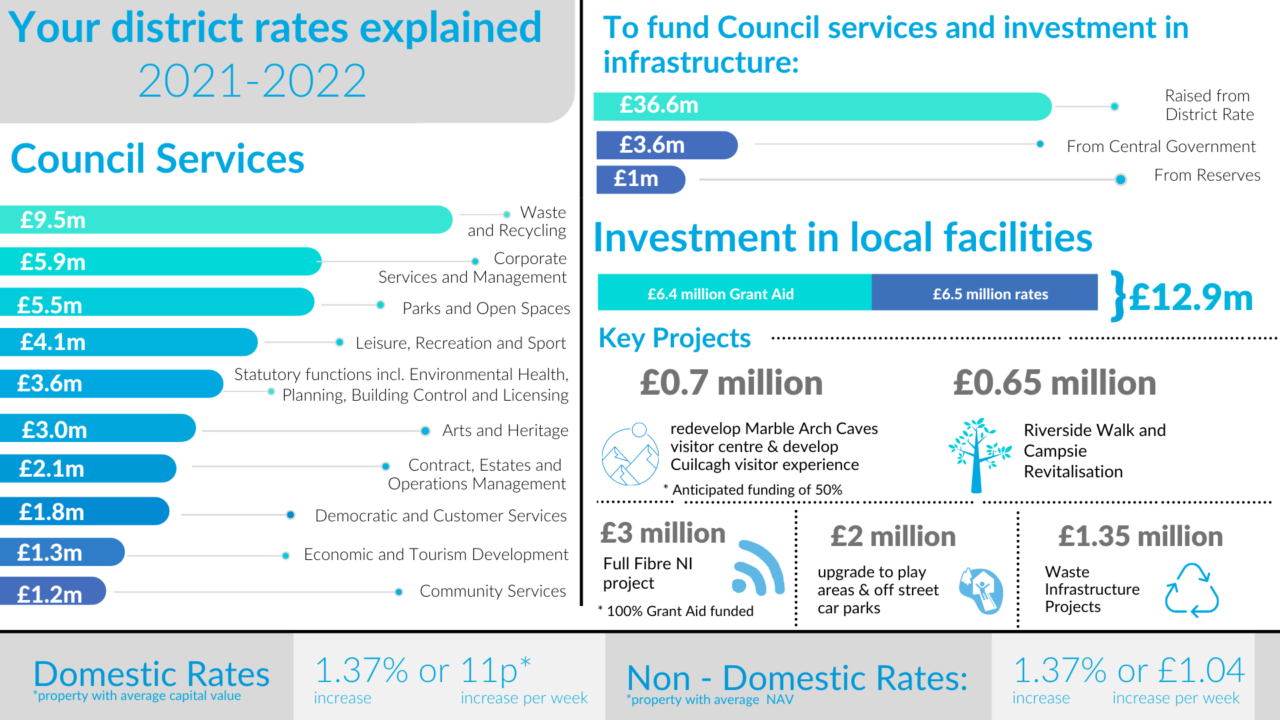Fermanagh and Omagh District Council agrees budget for 2021/22
19th February 2021

Fermanagh and Omagh District Council agreed its budget and the District Rate for 2021-2022 at a Special Council Meeting held virtually and live streamed via Fermanagh and Omagh District Council’s YouTube channel on Thursday 18 February 2021.
The setting of the District Rate will raise approximately £36.6m revenue for the Council with an additional £3.6m provided by central government funding and the use of almost £1m of reserves to fund local Council services and investment in infrastructure in 2021-2022 across the district.
Speaking after the Special Council Meeting, Chair of Fermanagh and Omagh District Council, Councillor Diana Armstrong, said:
“The Council budget has been impacted by the Covid-19 health pandemic and is clearly focussed on supporting recovery and improving the overall wellbeing of our people.
In line with Covid-19 restrictions, the Council, like many other organisations, has experienced a significant reduction in its income due to the closure or reduction in capacity of a number of its income generating services while costs to deliver other services increased due to additional demands and the implementation of Covid secure working service arrangements.
Council officers have worked to review overheads and other areas of expenditure across the Council and propose efficiency savings of almost £1 million in the next financial year to offset these losses and cost increases so as to minimise the impact on ratepayers overall.
Throughout the pandemic the Council has remained committed to supporting local communities and providing resources for them to respond to the impacts of Covid-19 and to provide information and support to businesses who are facing considerable uncertainty and challenges.
The Council is focussed on the recovery of the district and this year’s budget reflects the current circumstances and challenging financial climate we are operating within.”
Almost half (£16m) of the Council’s net expenditure is allocated to waste management including recycling services, street cleansing and maintaining clean and tidy open spaces. The remainder finances the operation of the Council and delivery of services across the district, the ongoing operation of Council venues and facilities and a range of projects and initiatives aimed at improving the wellbeing of Fermanagh and Omagh residents and the district.
The Council proposes a capital investment of £12.9m in local infrastructure, which includes and is subject to receipt of external funding of £6.4m. In line with a capital plan for the next financial year, a number of environmental, urban regeneration and economic development, tourism and leisure projects will be progressed. Some of these projects include Fibre NI broadband programme; upgrade of playparks and car parks; waste infrastructure projects; Riverwalk development and Campsie revitalisation project in Omagh; and Marble Arch Caves redevelopment.
The budget and the District Rate of a 1.37% increase for both domestic and non-domestic properties was agreed at the Special Council Meeting following extensive financial planning by Council Members and Officers with all relevant factors taken into consideration to ensure that adequate financial resource is available to meet Council priorities linked to the Fermanagh and Omagh Community Plan 2030.
The striking of the District Rate results in a 0.6% increase in the overall rates bill for domestic and non-domestic ratepayers for 2021-2022.
The increase means a domestic ratepayer with a property with an average capital value will pay approximately 11p more per week on their 2021-2022 overall rates bill while a non-domestic ratepayer with an average net annual value will pay approximately £1.04 more per week on their rates bill over the next financial year.
44% of total rates paid by Fermanagh and Omagh residents and businesses goes to the Council to fund Council services and investment in local infrastructure. The balance of the rates goes to central government for the provision of central government services such as roads, education, health, emergency services, law and order, social services and community development.
To view the supporting graphic, please click on this link.
-Ends-
